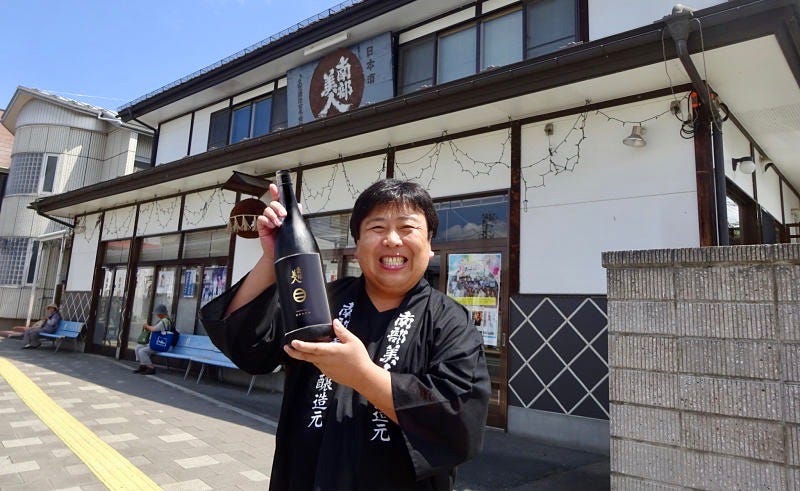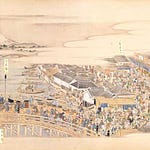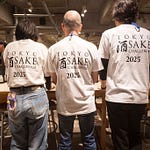World Sake Day is finally here!
From all of us at Sake Industry News we wish you all the best for World Sake Day! You don't need us to tell you what a crazy year it's been for the sake industry and the rest of the world, but for this day at least, let's do our best to focus on the good; and that is, there’s still a load of great sake out there and there's still plenty of dedicated brewers, retailers, importers/exporters and promoters bringing this wonderful beverage to us all over the world.
So on this day, we raise a glass to everyone in the industry and to all the drinkers that keep this fascinating, awe-inspiring, and glorious industry alive! Kampai!!
And finally, if this video of some of the Japan’s brewers and worldwide sake supporters showing off their questionable dancing talents doesn't put you in the mood for a Sake Day party we don't what will.
We have also made today’s newsletter free to both our paying and non-paying subscribers. If you are a paid subscriber - a huge thank-you for your support over the last year - without you there would be no Sake Industry News.
If you are teetering on the edge of a paid subscription - we really hope that you are able to join us - as a paid sub you get - 2 subscriber only posts per month (audio and email version) and complete access to all the Sake Industry News Archives, so teeter no longer - here is a link that gets your first two issues free!

Ok now for some news...
From The Editor: Please note that in our previous issue, an article regarding Naomi Osaka's involvement with SŌTŌ Sake contained some ambiguous wording which may have been interpreted to read that SŌTŌ Sake is an American-made product. For clarification, SŌTŌ Sake is produced entirely in Japan in Niigata Prefecture.
Sake Flavor Database Launched
Tokyo- A new app is joining the market to help consumers identify sake that suits their own tastes. Sakenowa was developed by Aiiro Systems and offers free data compiled by consumers for commercial and non-commercial use.
The app works as a community generated database. Users of the app enter information on sake they tasted to the database which groups flavor in six categories: aroma, richness, volume, mellowness, lightness, and dryness to create a tasting chart. Finer details describing flavor can also be hashtagged. Popularity rankings and basic information of each brand is also available.

There are currently 3094 sake registered in the app, and 2526 hashtags describing various flavor traits of sake. Of the sake registered in the app, approximately 933 brands have complete data with descriptions, hashtags and a complete flavor chart. Users can search for sake by brand and also flavor profile.

CEO of Aiiro Systems, Akira Ueda, said, "We've created an extensive and reliable database. Because this data is compiled by consumers for consumers, it is more easily relatable than complex tasting notes written by professionals."
Retailers can also use the chart to describe sake in their fridges as well as use ranking data to gauge which sake are popular with consumers. Sake can be searched for by brand or by flavor profile to find a sake of a specific style.
Currently, there are estimated to be around 5000 core/active users and monthly visit numbers are around 50000.
The app also has a built in translation feature which allows users to choose Japanese, English or Chinese.
Search for “Sakenowa” on your phones app store.
Source - Sakenowa
JG: Tech knows no bounds! However, it does seem easy to use and like something that might catch on.
Drone Technology Assisting In Rice Farming
Kanagawa- Popular brewery Izumibashi has stepped firmly into the new age by implementing drone assistance to monitor the growth and condition of the kura's rice fields.
Kanagawa Prefecture and Keio University are also assisting the brewery in this new approach to precision agriculture, using IT and other technologies.
On September 3, drones flew over the brewery's Yamada Nishiki fields and recorded pictures and video growth of stalk ears. The drones are fitted with a camera that is able to capture various wavelengths of red and green light reflected by leaves and stalks as well as near infrared data.
When photosynthesis is occurring vigorously, the red light is absorbed, and near infrared is reflected allowing the farmers to see which area of the field is undergoing healthy photosynthesis. According to Izumibashi, an overly active photosynthesis will increase protein in rice, which in turn can cause unwanted flavors in sake.

Traditionally, such checks were carried out manually and were gauged by the experience of the farmer, but going forward the brewery hopes to use scientific data to control growth.
Rice fields are divided into 30 plots which will be analyzed individually at each growth stage. Later they will check the quality of the harvest against the gathered data to understand the best way to use the information in the future.
Yuichi Hashiba, President of Izumibashi said, “We are a brewery that brews sake and grows rice. Now we have another method to improve our rice quality and in turn, sake quality. Until now we relied only on our experience to best manage rice growth, but now we can move forward with this new technology.”
Source - NHK
JG: I have seen great video footage of these drones in action and they do seem to be great labor-saving devices. I am sure other rice producers will begin to use these.
Izumibashi Shuzō 泉橋酒造
Dassai To Bring The Nightlife Back
Tokyo- Asahi Shuzō will be opening its latest venture, a Dassai-themed pop-up bar in the chic Tokyo suburb of Maronouchi, today October 1.
Originally, the brewery planned on setting up the bar as a stylish venue for visitors to the Tokyo Olympics, however with the Olympics postponed due to COVID, the plan was shelved. The bar was then reconsidered as part of the "bring back the Tokyo nightlife" campaign designed to reinvigorate the bar and restaurant scene in the wake of the financial downturn from COVID.
The small bar is located on the seventh floor dining area of the Shin-Maronouchi Building overlooking the cityscape and will offer a wide range of Dassai products. Drinkers will be free to roam about the floor and on to the outside terrace as weather permits.
Asahi Shuzō plans on keeping the bar open for eighteen months.
JG: Marunouchi is an easily accessible place, and again, kudos to Asahi Shuzo for making the most of a challenging situation. They do that again and again. Can’t wait to get there!
Asahi Shuzō 旭酒造
A Peculiar Smell Coming Out Of Kyushu
Fukuoka- A new release from Yamano Kotobuki Shuzō is gaining attention for its distinctive aroma not found in many other sake .
Yamano Kotobuki Freaks 2 is a follow-up to Yamano Kotobuki Freaks, which was brewed under a different concept from traditional Yamano Kotobuki. The sake is noted for featuring an aroma compound known as 4MMP (4-mercapto 4-methylpentan-2-one), widely considered a new aroma component for sake.
4MMP has been known to appear in white wine - mainly Sauvignon Blanc, and some hop-driven craft beer and is identified by bright, fresh aromas of grapefruit and muscat grapes.

Those that were able to taste the sake prior to its release described the taste as, "Totally different from traditional nihonshu," and "tasting of fresh watery muscat grapes, similar to wine."
Source - Hakata Keizai
JG: This kind of thing is genuinely interesting to me, and will be to other geeks as well. I am sure we will soon hear brewers and other tasters drop the 4MMP buzzword soon, like we hear the 4VG buzzword these days.
Yamano Kotobuki 山の壽
Sake And Cheese: The Perfect Match Realized
Wakayama- Cheese and sake is a pairing many have been lauding for quite a while, and now a cheese maker in Wakayama Prefecture is pushing the concept even further as he aims to create the perfect cheese for sake - made of course using sake lees.
Yoshitomi Miyamoto is the owner Copain du Fromage, a cheese specialty store. He obtained his cheese sommelier qualification in 2008, and opened his own store in 2014.
Last autumn, he began working on cheese made for sake after being invited to an event conducted by Kobe Shushinkan held to promote consumption of sake lees and their use in cooking.
Miyamoto's first prototype was released in February, but he felt the flavor of the cheese to be too rich for the elegant flavor of sake lees and pulled the product. He started to use milder cheese, such as French galle de la loire and German cambozola as a base, which seemed to work better with sake. To create his original cheese Miyamoto coated the cheese with sake lees and cacao butter and left it to mature for 20 days in cedar barrels in order to gain a mild cedar aroma reminiscent of a wooden masu similar to the way French cheese makers mature cheese in wine barrels.
Miyamoto is currently in talks with a prominent sake brewery to put together a sake and cheese set they hope will be served at the Nobel Prize Winners festivities scheduled to be held in December.
Source - Asahi | Copain
JG: Many people see the potential of sake and cheese pairings. Certainly this will bring more attention to that. The sake made by Kobe Shushinkan by the way is called Fukuju.
Kobe Shushinkan 神戸酒心館
Update: Hop-Infused Sake For Fukushima
Fukushima- As reported in our last issue, a new enterprise is coming to Minamisōma City in Fukushima Prefecture in the form of a brewery that will be producing a "new" style of sake made with hops. The company behind the project is Haccoba, with funds for the project generated through crowd funding site, Makuake. Although the brewery's official launch is set for February 2021, test batches will be available to funders in the coming months.
Minamisoma City became completely uninhabited after the nuclear power plant disaster of 2011. Although public transportation services and retail businesses are slowly coming back to the area, the population is still only about one third of what it was pre-disaster. Haccoba is hoping to become a part of this new community for locals and visitors with sake set to be a conduit to encourage discussions of social issues.
Haccoba plans on utilizing traditional sake brewing techniques, but with a "free-style" approach more associated with the craft beer movement. The company has obtained a license to produce "miscellaneous alcohol" beverages and not an actual seishu license, meaning the product will fall outside of the nihonshu category (although with hops as an ingredient we kind of saw that coming).
The hop-infused sake is actually based on a traditional method used in the Tohoku region many years ago known as hanamoto. This method was used in domestic production of sake and involved using hops early in the fermentation stage as a natural preservative to prevent spoiling. However this method all but disappeared once homemade doburoku brewing was outlawed. There is currently no brewery in Japan using the hanamoto method and Haccoba hopes to recreate the tradition.
Source - Medium | PR Times
JG: Even if it is not legally sake, I can’t wait to hop on down to the local liquor store and give this a try when it becomes available.
Hanamoto 花酛

Industry Stirrings...
Aichi- Aichi Prefecture Brewers Association and radio station, ZIP-FM, have collaborated on a project specially for International Sake Day. With the cooperation of 25 breweries from the region, a collaborative sake, Akizake Zoroe has been released. Each participating kura brewed its own Akizake for the project and then labeled it with the shared Akizake Zoroe label. Sets were available in randomly selected three, six, twelve bottle sets as well as a full twenty five-bottle set. This is the first time the Aichi Brewers Association has worked together on such a project. Unfortunately (although fortunately for the breweries), the sets have all been completely sold out!
In past years, ZIP-FM has held an Akizake festival on October 1 to commemorate Sake Day, but this year opted to organize the special release rather than attempt to hold a festival in the current climate.
The participating breweries were:
相生ユニビオAioi Unibio, 青木酒造 Aoki Shuzō, 浦野酒造 Urano Shuzō, 神杉酒, Kamisugi Shuzō, 神の井酒造Kaminoi Shuzō, 甘強酒造 Kankyō Shuzō, 金虎酒造 Kintora Shuzō, 勲碧酒造 Kunpeki Shuzō, 澤田酒造 Sawada Shuzō, 柴田酒造場 Shibata Shuzōjō, 関谷醸造 Sekiya Jōzō, 東春酒造 Toshun Shuzō, 内藤醸造Naito Jōzō, 中埜酒造Nakamori Shuzō, 永井酒造場 Nagai Shuzōjō, 原田酒造場 Harada Shuzōjō , 丸石醸造 Maruishi Jōzō , 丸一酒造Maruichi Shuzō, 盛田Morita, 盛田金しゃち酒造Morita Kinshachi Shuzō, 山崎 Yamazaki, 山田酒造 Yamada Shuzō, 山忠本家酒造 Yamachu Honke Shuzō, 山盛酒造 Yamamori Shuzō, 渡辺酒造 Watanabe Shuzō
Source - Jiji
Kuramoto Introduction- Nanbu Bijin
Welcome to a new addition to Sake Industry News, the Kuramoto Introduction. This will replace the Kura Profile section that was part of SIN until now. While it might be easy to assume that it’s just “six of one, half dozen of another,” in truth we hope this section will give a more well-rounded introduction of each brewery we cover, including history, the brewery, tōji, the basic style of the brand(s) they produce, and a bit of color as well. The goal of all this is to make you want to try their sake, once you have a feel for the place!
We will bounce around Japan with this, introducing well-known brewers and lesser known brewers, big and small, and what other significant variations there might be. We hope you enjoy this enhanced section of our newsletter. Be sure to let us know!

We will begin with Nanbu Bijin Shuzō of Iwate Prefecture, the brewers of Nanbu Bijin sake. The company has been in existence since 1902, and is headed by Mr. Kosuke Kuji, the fifth generation of his family to run what is now the eponymous Nanbu Bijin Shuzō.
In truth, we had interviewed Kuji-san at the end of last brewing season. However, our publishing schedule became a bit backed up, and we never got around to putting that interview in the newsletter. Since it seemed incongruous to publish something about last season as we are just embarking on a new one, we decided to take this opportunity to shift our content a bit. This Kuramoto Introduction section of SIN will take form and shape as time goes on, but for the first shot, Kuji-san is a great choice.

The Region
The brewery is located in the city of Ninohe in the northern part of Iwate, pretty close to Aomori Prefecture. The whole area was long ago under the jurisdiction of a family named Nanbu, and in fact that is the former name of Iwate Prefecture. Also, the (arguably) most significant toji guild in Japan, the Nanbu Tōji, are from here and take the old name of the region. So, yes, Nanbu Bijin is brewed by a Nanbu Tōji in the land originally known as Nanbu.
The Kura
The kura building itself is 160 years old, and was in fact owned by another family and used for making miso when the Kuji family bought it in 1902. It has a typically sprawling layout, with some special qualities being the well from which the water is drawn being just inside the entrance. But their success of late has meant they have outgrown the brewery, and cannot make any more sake in it.
So they built and opened a second brewery a short drive away in a neighborhood called Basenkyo. The amazing thing about that was that it was the first new license granted by the local tax authorities in 30 years.
The Owner
Kosuke Kuji is the fifth generation president of Nanbu Bijin Shuzō. He’s bursting with energy, light-heartedness, positivity, and he talks a mile a minute! Like many of his brewery-owner colleagues of their generation, he graduated from Tokyo Agricultural University, and is very tech savvy. You can meet him and learn more about him by watching the movie, “Kampai: for the Love of Sake.”
Tōji
The current tōji at the main brewery is Junji Matsumori of the Nanbu Guild. He took over from Hajime Yamaguchi, one of the most famous tōji of his time, who had been there since 1951. Matsumori Tōji has already established his prowess as a brewer, having won six consecutive gold medals in “the nationals.” That’s no mean feat.

Water, Rice, Yeast
Nanbu Bijin is fairly isolated, with the closest brewery being an hour away, and the water source is different from the others in the region. The well itself is quite shallow, like ten meters, and the water it provides is a bit on the hard side in terms of mineral content, at least compared to most sake breweries in the area. This leads to a fairly vigorous and fast fermentation. But it is incredibly pure, and sees no filtration at all before use.
Most of their rice (80 percent) is grown in the prefecture, with just a bit of Yamada Nishiki, Omachi and Aiyama – all rice grown in western Japan - for a few of their products. They use a wide range of yeasts, and in fact lean heavily toward the more aromatic strains perhaps more than average.
Production
The company brews about 3500 “koku” yearly, which (at 180 liters per koku) is about 630 kiloliters. This has grown about 30 percent over the 20 years or so, in an industry where consumption overall has contracted significantly across the same time period.
The sake is all handmade, with almost no machines involved and is split across two brewing facilities. Recent technical developments include pasteurizing all their sake in-bottle (as opposed to before bottling), flash-cooling the bottles after that, and then storing all their sake at -5C, not just the namazake.
“The differences are huge,” he emphasizes, referring to storing at -5C versus +15C, as most do.
The Sake
Nanbu Bijin sake has plenty of consistency running through the product line of 80 or so products (including seasonal products). When asked to describe his sake, Kuji-san replied, “Abstractly speaking, it’s light-hearted sake that makes one smile. More concretely, it’s fresh, fruity, and juicy, with a quick finish.”
Indeed, for the most part, it is youthful, light and quaffable. It represents the Tohoku (the northern region of Japan) style very well. Most of it is only matured a few months, which contributes to that style. With the exception of one or two tanks of kimoto made specially by Kuji-san’s younger brother, they make no yamahai or kimoto as it does not fit in with their style.
Furthermore, Nanbu Bijin sake is the kind of sake that does very well in contests. From the Japan National New Sake Competition to IWC competitions and others, they are a well-decorated company.
Nanbu Bijin also makes a few special products. They were the second brewery to make a certified Kosher product, and the first company to make a certified Vegan sake – which all of their products are. Once other brewers realized how easy it is, since sake is so close to being Vegan anyway, many other breweries followed suit. They also make a lot of nihonshu-based umeshu (plum sake), and while not legally sake it is very enjoyable.
Why in the world would a brewer want to make Kosher sake, and Vegan sake? Kuji-san explains, “Most of the people that enjoy sake overseas have some connection to Japan already. I want to help sake be enjoyed by people outside of that group. And one of the walls to bring down was religious restriction. By having a certified Kosher product, that is no longer a problem.”
Kosher came first, after which someone in the US asked why he doesn’t make a Vegan product as well. This got him thinking, and he followed through and made it happen.
“And now,” he continued, “one dietary restriction barrier to enjoying sake has been removed as well!”
COVID Effects
As they are primarily a premium sake producer, they were initially hit hard by COVID. Shipments from the brewery dropped 20 percent in April and May. They have, however, slowly recovered to close to normal. Exports too dropped hugely, but exports to Asian countries have returned. For other places like the US and Europe, the recovery has been much slower.
Other Notes
Kuji-san expends a lot of effort on online events and promotion, much of it good and entertaining fun, together with other brewery owners. He notes that, “Look, over the centuries our industry has been through many things, other pandemics – and worse. And we have survived. If we just grumble, nothing will happen. We need to show the sake-loving world that we are energetic and enthusiastic in spite of it all.”
The company exports about 20 percent of their production to countries all over the world.












Share this post